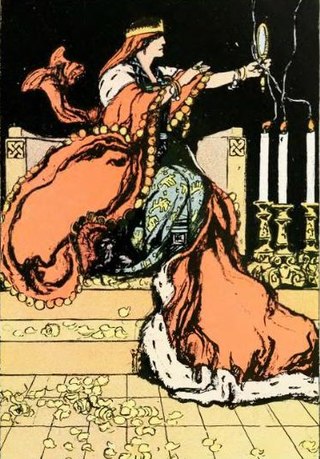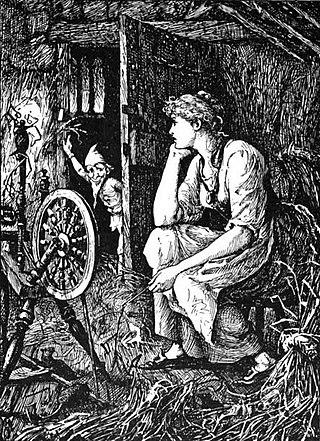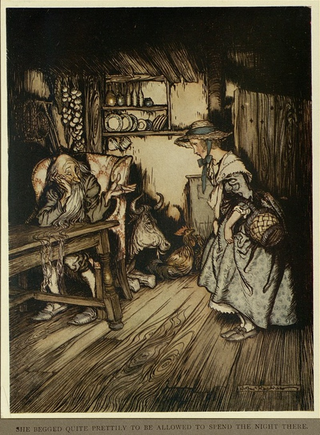| The Glass Coffin | |
|---|---|
| Folk tale | |
| Name | The Glass Coffin |
| Aarne–Thompson grouping | ATU 410 |
| Country | Germany |
| Published in | Grimms' Fairy Tales |
"The Glass Coffin" is a German fairy tale collected by the Brothers Grimm, tale number 163. [1] Andrew Lang included it in The Green Fairy Book as The Crystal Coffin. [2]
It is Aarne-Thompson type 410, Sleeping Beauty. Another variant is The Young Slave . [3]
A tailor's apprentice became lost in a forest. When night came, he saw a light shining and followed it to a hut. An old man lived there and, after the tailor begged, allowed him to stay for the night. In the morning, the tailor awoke to witness a fight between a great stag and a wild boar. After the stag won, it bounded up to him and carried him off in its antlers. It set him down before a wall of stone and pushed him against a door in it, which then opened. Inside the door, he was told to stand on a stone, which would bring him good fortune. He did so, and it sank down into a great hall, where the voice directed him to look into a glass chest. The chest contained a beautiful maiden, who asked him to open the chest and free her, and he did so.
The maiden told him her story: She was the daughter of a rich count, and after the death of her parents, she had been raised by her brother. One day, a traveler stayed the night and used magic to get to her in the night, to ask her to marry him. She found the use of magic repellent and rejected his proposal. In revenge the magician then turned her brother into the stag, imprisoned her in the glass chest (coffin), and enchanted all the lands around them.
The tailor and the maiden emerged from the enchanted hall and found that the stag had been transformed back into her brother. The wild boar he had killed had been the magician. The tailor and the maiden then married.
The Glass Coffin has been compared to Snow White, which shares the motif of the woman inside a glass coffin.
“The Glass Coffin” first appeared in the 1837 collection of the Grimms’ fairy tales. It is not a collected folktale like others in the collection. Instead, the Brothers Grimm adapted it from a section in the 1728 novel Das verwöhnte Mütter-Söhngen by Sylvanus. [4] They considered it to have “some affinity to a genuine saga.” [1]

"Snow White" is a German fairy tale, first written down in the early 19th century. The Brothers Grimm published it in 1812 in the first edition of their collection Grimms' Fairy Tales, numbered as Tale 53. The original German title was Sneewittchen; the modern spelling is Schneewittchen. The Grimms completed their final revision of the story in 1854, which can be found in the 1857 version of Grimms' Fairy Tales.

"Sleeping Beauty", also titled in English as The Sleeping Beauty in the Woods, is a fairy tale about a princess cursed by an evil fairy to sleep for a hundred years before being awakened by a handsome prince. A good fairy, knowing the princess would be frightened if alone when she wakes, uses her wand to put every living person and animal in the palace and forest asleep, to awaken when the princess does.

"Beauty and the Beast" is a fairy-tale written by French novelist Gabrielle-Suzanne Barbot de Villeneuve and published in 1740 in La Jeune Américaine et les contes marins.

The Evil Queen, also called the Wicked Queen or simply the Queen, is a fictional character and the main antagonist of "Snow White", a German fairy tale recorded by the Brothers Grimm. The most popular adaptation of the Evil Queen is from Disney's Snow White. The character has also become an archetype that has inspired unrelated works.

"The Twelve Dancing Princesses" is a German fairy tale collected by the Brothers Grimm and published in Grimm's Fairy Tales in 1815. It is of Aarne-Thompson type 306.

"The Singing, Springing Lark", "The Singing, Soaring Lark", "The Lady and the Lion" or "Lily and the Lion" is a German fairy tale collected by the Brothers Grimm, appearing as tale no. 88.

The Langs' Fairy Books are a series of 25 collections of true and fictional stories for children published between 1889 and 1913 by Andrew Lang and his wife, Leonora Blanche Alleyne. The best known books of the series are the 12 collections of fairy tales also known as Andrew Lang's "Coloured" Fairy Books or Andrew Lang's Fairy Books of Many Colors. In all, the volumes feature 798 stories, besides the 153 poems in The Blue Poetry Book.

The Iron Stove is a fairy tale collected by the Brothers Grimm, as tale number 127. It is Aarne–Thompson type 425A, "The Animal (Monster) as Bridegroom". Dorothea Viehmann prepared the story for the Grimms' collection.

"Bearskin" is a fairy tale collected by the Brothers Grimm. A variant from Sicily, "Don Giovanni de la Fortuna", was collected by Laura Gonzenbach in Sicilianische Märchen and included by Andrew Lang in The Pink Fairy Book. Italo Calvino included another Italian version, "The Devil's Breeches" from Bologna, in his Italian Folktales.

The Two Brothers is a German fairy tale collected by the Brothers Grimm, tale number 60. It is Aarne-Thompson type 303, "The Blood Brothers", with an initial episode of type 567, "The Magic Bird Heart". A similar story, of Sicilian origin, was also collected by author and folklorist Andrew Lang in The Pink Fairy Book.

"The Hut in the Forest" is a German fairy tale collected by the Brothers Grimm. Andrew Lang included it in The Pink Fairy Book (1897). It is Aarne-Thompson type 431.

"The Queen Bee" is a German fairy tale collected by the Brothers Grimm in Grimm's Fairy Tales. It is of Aarne-Thompson type 554.

"The Brave Little Tailor" or "The Valiant Little Tailor" or "The Gallant Tailor" is a German fairy tale collected by the Brothers Grimm. "The Brave Little Tailor" is a story of Aarne–Thompson Type 1640, with individual episodes classified in other story types.
"The Riddle" is a German fairy tale collected by the Brothers Grimm in Grimm's Fairy Tales in 1819. It is of Aarne-Thompson type 851.

In folklore and fantasy, an enchanted forest is a forest under, or containing, enchantments. Such forests are described in the oldest folklore from regions where forests are common, and occur throughout the centuries to modern works of fantasy. They represent places unknown to the characters, and situations of liminality and transformation. The forest can feature as a place of threatening danger, or one of refuge, or a chance at adventure.
"The True Bride" or "The True Sweetheart" is a German fairy tale collected by the Brothers Grimm in Grimm's Fairy Tales as tale 186.

"The Two Kings' Children" is a German fairy tale collected by the Brothers Grimm in Grimm's Fairy Tales, tale number 113.

In fairy tales, a donor is a character who tests the hero and provides magical assistance to the hero upon their success.
The Story of Princess Zeineb and King Leopard is a French language fairy tale published in the 18th century. The tale belongs to the international cycle of the Animal as Bridegroom as a subtype, with few variants reported across Europe. In it, the heroine is delivered to a cursed or enchanted prince, but breaks a taboo and loses him; later, she finds work elsewhere and wards off the unwanted advances of male suitors with the magical object her enchanted husband gave her.
The Drummer is a fairy tale. It appears as the 193rd tale the Grimms' Fairy Tales of the Brothers Grimm published in 1843.